#cercis seedling
Note
👪 🍩🌺🙈🙊🙉🌱 All Cerci
👪 FAMILY - what is their family like? what is your ocs relationship to them? does your oc have any siblings?
I did not think that far tbh.. I don't usually like make parents for my OCs unless they're gonna be plot relevant or like hold some importance or whatever (like with Kari for example)
🍩 DONUT - favourite sweet treat?
I dunno??
🌺 HIBISCUS - do they have any allergies?
no its a bug i dont usually think about these kinda things again unless it'll be plot relevant also like i dont actually know if bugs can have allergies
🙈 SEE-NO-EVIL - whats a side of your oc that they don't want to show other people?
Nothing tbh hes literally the most average guy ever and even if he did have something interesting happen he'd be talking about it to everyone for weeks
🙊 SPEAK-NO-EVIL - what is something your oc will refuse to stay quiet about?
I dunno?? again literally the most average guy ever
🙉 HEAR-NO-EVIL - what is the worse thing your oc could hear from someone?
I have no idea
🌱 SEEDLING - what is their most vivid memory from childhood?
I have literally never thought about this with it before
No offence but Cerci is literally the most average guy ever and has no story significance at all there is very little I could tell you about it
4 notes
·
View notes
Text
Wednesday 5 December 1832
6 50
11 10
F45 ½° at 7 – dark – when light fire frosty morning - about an hour thinking and writing what to write to Miss W- about Mr Briggs’s note - took 2 quarter sheets and wrote the one full the other ½ full to Miss W- saying I should send Hemingway over as not having hoped to see her (Miss W-) today I had so made my arrangements that I could not be with her before this afternoon much too late for her postboy would then explain - sent her a copy of letter to her dressmaker and of note to Messieurs Briggs said they were legally right ‘the same thing has often fallen under my experience before faithfully and affectionately yours AL’ - much obliged to Messrs. RB- and son for their note and has written by today’s post to Mrs Anne Williams, to desire her to draw on Messrs. Williams Deacon and co. Bankers for £8.2.6 payable to herself or order on Miss W-‘s account, by Messrs. RB- and sons, Bankers, Halifax’ - put my note with that from Messrs. RB- and sons in an envelope and put in the packet in the little carton that came the other day with the 4 frills Miss W- had made for me and left it on my desk for Hemingway to take this morning to ‘Miss Walker Lightcliffe’ and went down to breakfast at 9 35 - out at 11 ¼ with Pickles and his son John and John Booth (having waited for Holt) holing - Holt came about 11 ½ - read him Mr Jeremiah Rawson’s last note which he Holt thought as odd as I did - said I valued the upper or hard bed at £160 per acre which he thought very fair - but said he thought to allow them £10 per acre out of it in consideration of the dearness of the Lower bed at £230.10 would be enough – then went to James Smiths’ brow just above the Lower brea branch road to see about getting water – Mr. Wilkinson met us there and George Robinson – then went into the lower Daisy bank, near the house and Holt advised to sink there to the 36 yards coal band – would be done at 3/. a yard - came in at 1 – found a note from Miss Walker begging me to go as early as I could in the afternoon – her visitors to leave her at 4 to drink tea at Cliff Hill - ‘I will not ask you to stay all night, and indeed if I did I scarcely think you would’ - very much obliged ‘more thanks than I can express about Mrs Teasdale’ - determined to dine there and return at 9 - found also parcel from the nursery at Leamington Cullis and co. sent by M-‘s order the 6 Cercis siliquastrum (arbour Judae or Judas trees) and 6 evergreen Luccombe [Lucombe] oaks, and ½ gallon of Spanish chesnut ditto mossy cup acorn ditto quercus pedunculatus - very nicely packed in [string] - took John and had the trees planted immediately - then till after 4 with him and Pickles and John P- holing and getting in 300 hollies from Throps’ - 164 of them almost like seedlings -sad disappointment - set off to Lidgate at 4 ¼ - rain – turned back and waited in the hut till the shower was over, at Lidgate at 5 – dinner (mutton steak) a little before 6, tea at 6 – cosy evening – said how much I enjoyed out quiet tête-à-tête and was in very good spirits - Miss Parkhill and Miss and Miss Emily Rawson of Millhouse returned about 9 - merely civil to Miss P-, kind and attentive to the 2 Misses R- - said my visit must be taken as partly to them - Miss W- read prayers – rainy evening so had determined to stay all night – went upstairs at 10 ½ - fine day till a shower soon after 4 – fair while I walked to Lidgate but afterwards rainy evening
3 notes
·
View notes
Note
❝ i don't know what it is about you, but, you just ... you're the only one who can make me feel like this. ❞ -steferci
@myhiraeth
"That's quite the coincidence... as you do the same to me." But Cerci had always done that to him.
She had a way of permeating through his skin and into his very being by just existing in his sight. He'd never forget the first time he laid eyes on her- how lush dark hair shone under the sunlight and dark eyes shimmered curiously as she looked at him. Self consciousness was something he never suffered from except in that one moment when he stood beside the Commander of the Stygian Omada, but he saw her eyes were set just on him. Never had he felt so free to speak to a woman- a goddess until that day.
She might as well have been a goddess in his eyes with the way the sweet scent of her skin lingered in his nose tormenting him for a taste of it. Surely only the gods could torture a human soul like that. The soft cultured lit of her voice might as well have been a siren's song as he'd have followed it anywhere blindly and done anything it asked. She certainly had the talents of the sorceress her name bore, but the soft gentle heart that said otherwise to keep the distinction. No one had ever worked a spell on him as Cerci had then and what she did now.
Now it was insatiably charming. The softness in her eyes, the hesitation and propriety- a flustered facade to hide the raptor sharp intelligence he knew laid behind it. He knew his wife. She may not remember it, but she would because he knew there was a crimson cord between them that wouldn't be cut by the fates themselves. He wouldn't let them. So he'd worked as he did all his missions- slowly, methodically and intentionally. The choice was hers, but he'd take every chance to nudge the seedling that was their past into full bloom within the garden of her thoughts. He knew that she was his and he was utterly completely hers. Some things just took time and he'd continue to meticulously tend to his wife till she either asked him to leave or remembered.
Yet if what she said was true then he knew that just maybe he'd have her in his arms again soon. To inhale the softness of her fragrance and feel the tender touch of fingertips that saw beyond the cold facade he left for others. To kiss her and take her and never leave her side again. He'd trade his soul to any other god again if it meant it'd keep her by his side.
"Perhaps its the ancient history, akribos. " His voice low and resonant as he leaned against the side of her desk where she sat just inches from him. " Perhaps its recognition, habibi. I've seen far stranger things in my life now than mere reincarnation...if you're inclined to believe me."
1 note
·
View note
Text
Low maintenance trees for your garden
Post has been published on becoration
Low maintenance trees for your garden
If you’re lucky enough to have a garden in your house, even if it’s a small garden on your terrace, you probably have some plants that brighten up your day every time you go out. But have you ever thought about including trees? In the case of a garden, you can put one, two, or as many as you want based on the space you have. If your ‘garden’ is your terrace or balcony, you can also add a dwarf tree. But, what are the best low-maintenance trees for your garden?
If you want to know them and be sure they won’t give you any extra trouble in their care, take note of this list we have prepared for you with the aim of selecting the ones you like knowing that they will give you very little work. Shall we start?
Jacaranda
This is one of the most beautiful low-maintenance trees, especially because it has blooms in blue and lilac tones. It is a tree that loves the sun and doesn’t need you to be very attentive to it all the time. It can reach heights of 12-15 meters if you let it, although it will depend on the space you give it to grow more or less.
However, we must warn you that, due to the nature of the flowers, it tends to attract bees, wasps, and butterflies. If you don’t have a problem with that, go ahead because it will be a very beautiful sight. And before you say it, yes, you may have to sweep a bit in summer or autumn to remove the flower petals from the garden.
Mulberry
Another low-maintenance tree for the garden is the mulberry. We can tell you that you can have it at whatever size you want, which also means it will work for a balcony or terrace.
Its main characteristic is its resistance and vigorous growth. If you leave it in a large garden, it will grow quite a bit and, best of all, you will get good shade from it. Additionally, as its name suggests, we are talking about a mulberry tree, so you will also enjoy a fruit that you may love (especially because it will be more natural than what you buy at the supermarket).
Cercis siliquastrum (Judas tree)
And what about a tree considered the “tree of love”? That’s what this tree is called because its leaves grow in the shape of a heart. Without a doubt, if you’re romantic, this is one of the low-maintenance trees that will enchant you and that you will want to have, no matter what, in your garden or even on the terrace. Furthermore, if that doesn’t convince you in itself, know that it blooms with very abundant pink flowers that make the whole tree look pink.
In fact, this species is quite resistant and adapts to different environments, so if you want a tree that also decorates, this is one of the best. And again yes, you can also have it on the balcony or terrace without any problem.
Albizia
You might not know it by this name, but if we say “mimosa”, things may change. The most beautiful thing about this tree is the foliage it offers and the flowering that will appear in summer and early autumn, with an incredible aroma.
As for care, it doesn’t ask for much, like all the low-maintenance trees we have talked about, and it is ideal for medium and small gardens, especially because you will have a little shade around it.
Loquat
Another low-maintenance tree is the loquat, which besides being a beautiful tree throughout the year (as it is evergreen), will give you fruits and flowers. So you can enjoy a sweet fruit freshly picked from the tree.
First, you should know that loquat is cold-resistant and very easy to care for. However, when they are small (seedlings) they will need you to be a little more attentive to them. But once they adapt, they will start to grow without any problem and give you fruits. You could even reproduce them from the fruits and have several trees.
It can reach heights of 10 meters, but you can also have a tree a couple of meters tall in a pot (or in the ground). So, as long as you control it, there won’t be any problem in having it in the garden, terrace, or balcony.
Mediterranean laurel
We continue with the low-maintenance trees for the garden and add the laurel. It is one of the trees that needs the least care and, in return for practically nothing, will give you a dark green and very fragrant foliage.
You can use the leaves in the kitchen, making it practical. In addition to beautifying your garden or terrace, you will have an additional ingredient for many of your dishes.
Maple, one of the most beautiful low-maintenance trees
And we end with another low-maintenance tree that has been trendy for gardens in recent years. In principle, there are many maple trees, in many color tones in their leaves. But in addition, changing color in autumn, with the sun, etc. makes many look for it to add a color show to the garden.
These trees are said to grow rapidly, but in those cases they do need more care than if you leave them alone to determine how to proceed. When they are small, they have limited resistance to cold, and even more to heat. So be careful with that, especially if you live in an area where summers are like hell.
Can you think of more low-maintenance trees? Olive trees, cypress trees, or lagerstroemia are other examples we can give you. Which one will you choose?
via: MiMub in Spanish
0 notes
Photo



These siblings are constantly catching the train into the city and getting in trouble... they think they’re getting away with it
26 notes
·
View notes
Text
Evening Gardeners,
Now is the time to start your garden plans for the Maritime Northwest climate. Getting a jump on your season can save you a headache or two once the physical planting time comes.
LENGTHY POST AHEAD
GENERAL INFORMATION
Check your garden soil. Preform a pH test and amend your soil if necessary. If you are planning on a diverse pH planting, make sure your planting area and it’s medium is set for the specific vegetation. Ex, blueberries will require a more acidic pH medium than leafy vegetables.
Weed your garden. Seriously. Start weeding now, your produce seedlings will thank you. The less they have to compete with at a young age, the stronger plant you will have.
Turn your soil. Especially the areas that got hit by the 2021 February snowstorm. Turn your soil after weeding your garden. If you need to amend your soil, this is a good time to do it as you will be mixing your amendments throughout your entire growing area.
Start your warm season seeds indoors. If growing potatoes or fava beans, have their growing plot ready to go by March. Sprout your potatoes a week or so prior to planting. If you need to divide a large seed potato, make your cuts are done 2 days minimum prior to planting to reduce the risk of rot. Fava bean (seeds or starts) can go directly into the ground the first week of March as they are cold hardy and can tolerate light frost.
Start pest prevention early. For slugs use copper tapes and salts to deter them from your seedlings. Use cabbage collars on your cabbage seedlings to prevent cabbage root flies from getting at the stems. Net your seedlings in advance for prevent loss to birds. Use floating row covers while seedlings are young to prevent pest damage and to keep some extra warmth. Don’t forget to remove covers as the weather warms up so benifical pollinators can reach your garden.
Check your garden tools are sharp, oiled, and ready for the growing season.
FOR CANNERS ONLY: If you plan on canning your harvest this year, stock up on a case or two of your preferred canning jars. Once canning season is in full swing, items such as lids, rings, jars, pectin, etc. can be difficult to find.
Try something new. Save a small patch of space in your garden to test out a single planting of a crop you have always wanted to grow! If it performs well, you can add it to next year’s plans. If it doesn’t meet you expectations, you didn’t put a large amount of cost into growing the crop and can try something else next year.
SEED COMPANIES
Below is a list of seed companies I trust and use in my garden. My personal favorite are highlighted in green:
Seed Savers Exchange
Territorial Seed Company
Seattle Seed Company
Heritage Harvest Seed
Seeds of Change
Victory Seed Company
MIGardener
Ed Hume Seeds
GENERAL GARDEN FAQ
1 inch of water equals 16 gallons (60.5 liters)
Succession plant crops every 2 weeks for continuous harvest.
Preform a vigilant 4 year crop rotation to prevent disease in your soil.
Plant marigolds among your crops to keep pests away.
Use flash tape and netting to keep birds out of the garden.
Plant flowers and herbs for benifical insects to assist in your gardens pollination. Some of the best flowers for bees are:
Lavender – Lavandula spp.
Rosemary – Rosemarinus officinalis
Sage – Salvia spp.
Coneflower – Echinacea spp.
Sunflower – Helianthus spp.
Redbud – Cercis spp.
Catnip – Nepeta spp.
Penstemon – Penstemon spp.
Lamb’s Ear – Stachys spp.
Verbena – Verbena spp.
Bells of Phacelia – Phacelia spp.
Black-eyed Susan – Rudbeckia spp.
Oregano – Origanum spp.
Yarrow – Achilliea millefolium
Honeywort - Cerinthe major
Ask box is always open on this blog. There is never a need to wait until a Submission Saturday to ask for help with your garden.

#garden#gardening#outdoor garden#maritime gardening#maritime#pacific northwest#food garden#outdoor plants#produce garden#growing your own food#soil structure#soil#sprouts#seedlings#seasons#seeds#sustainable#fruit garden#how to grow#food gardening#vegetablegarden#vegetables
75 notes
·
View notes
Photo

Trick or Trees! 🎃🍂🍁👻 The Garden is excited to welcome Bartlett Tree Experts for a complimentary “Ask an Arborist” consultation at the Main Entrance from 10am to 2pm on Halloween, this Saturday, October 31st. 🌳 In addition to advice on tree care, Bartlett will be giving out Gingko biloba, western redbud (Cercis occidentalis), and crepe myrtle (Lagerstroemia) seedlings for you to take home and grow your own tree! (Available while supplies last) 🌲 #sfbotanicalgarden #halloween #bartletttreeexperts #bartletttree (at San Francisco Botanical Garden) https://www.instagram.com/p/CG8ibgDAAZc/?igshid=bewdildcixc3
2 notes
·
View notes
Photo
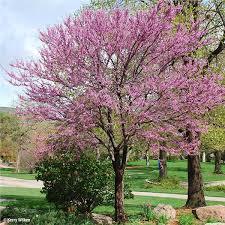
Cercis Canadensis - Eastern Redbud
Family: Sapindaceae - Soapberry
Native region: Eastern Central Europe
Landscape uses: Invasive, do not use
Height and Width: 50-70′ Tall 30-50′ Wide
Zones: 3-9
Drought conditions: Moderately
Transplants: Yes
Preferred Growing Conditions: Easily grown in average, medium to wet soils in full sun to part shade. Prefers moist soils, but shows somewhat surprising tolerance for poor dry soils.
Tree & Plant Care: Without proper and frequent pruning high winds and ice can cause limbs to break. Prune in summer. Drought sensitive, provide supplemental water in dry periods. Many authorities recommend against planting silver maple.
Disease, pests, and problems: May be weedy, spreading many seedlings in lawns and gardens. Weak wooded and is prone to storm damage.
Has a vigorous root system that can invade sewer pipes.
Verticillium wilt, anthracnose, tar spot, cottony maple scale, maple bladder gall.
Seal of Ian’s DISApproval: Not native and will kill any plant around it. The roots are too greedy and it covers too much with its shade. Invasive.
PLANT COMMUNITY !!!!!!
1 note
·
View note
Text
Earwigs
How to Get Rid of Earwigs (or “Pincher Bugs”)
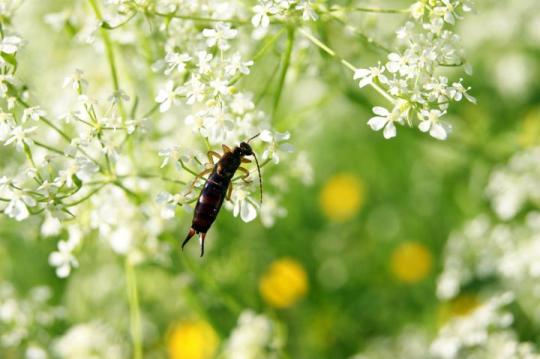
You're reading: Earwigs
Here are tips on how to identify and get rid of earwigs, also known as “pincher bugs,” in the garden.
What Are Earwigs?
Earwigs can be found in almost any growing zone, although they are more likely to inhabit warm, humid climates. You might have trouble spotting one—not only are they quick movers, they are also nocturnal, and tend to hide out during the day when you are tending the garden. They like decaying wood and plant material, and dark, damp spaces. Oftentimes, they can be found in basements and woodpiles.
Read more: Does Your Lawn or Garden Need Lime?
Earwigs are the sole members of the insect order Dermaptera, ancient bugs that began crawling around Earth about 208 million years ago. Today, nearly 2,000 species are scattered everywhere but in Earth’s polar regions. The name “earwig” comes from the Old English ear-wicga, which means “ear wiggler”—so named because the insect was once thought to seek out human ears to reside in. In France, they’re called “ear piercers,” and in Germany, “ear worms.”
In North America, we’re most familiar with Forficula auricularia, a European species thought to have arrived with our immigrant ancestors. Earwigs were first reported in North America in the early 1900s, and they have now spread to most of the United States and parts of Canada.
Earwigs enjoy a lively social scene. They congregate during the day because they tend to find the same hiding places. Their nests can number in the thousands, and they aren’t territorial, so they often live together.
What Do Earwigs Eat?
Pincher bugs are omnivores, meaning they’ll eat pretty much anything that’s made available to them. In the garden, they primarily feed on dead or decaying plant and animal matter. However, they will also readily prey on aphids, insect eggs, maggots, grubs, and army worms. When their population gets out of control, they may turn to feasting on living plant matter, especially the seedlings or young foliage of vegetables and flowers.
This creates a conundrum for gardeners… Should earwigs be allowed to remain in your garden to eat up aphids and other pests? Or should they be removed before they turn their attention on your plants? Generally, earwigs do not cause enough damage to be worth fighting. However, if you do see large numbers of them around your plants, you can consider taking action.
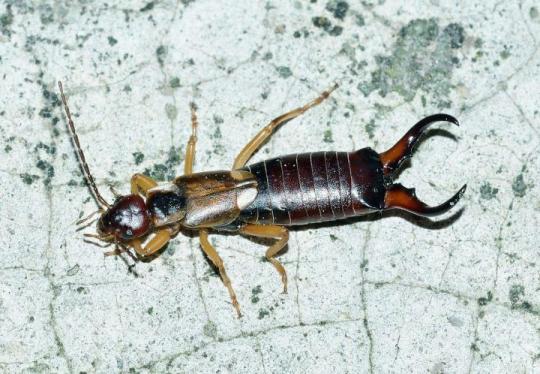
Read more: Store Directory – Garden City Center
Do Earwigs Pinch?
The pincers at the end of an earwigs abdomen look rather formidable. They are capable of pinching (and sometimes biting) humans, but the pinch is not particularly powerful. Earwigs usually use their pincers to ward off enemies like toads and birds, or—in some species—to catch prey.
The pincers, or “cerci,” are also important for romance. They are indicators of gender, like tusks on an elephant. A male earwig’s pincers are long and curved, while a female’s are shorter and straighter.
Identification
How to Identify Earwigs
Earwigs get to be about ¾-inch long. They’re reddish-brown insects with appendages on their tail-ends that look like forceps. Few other insects have a set of scary-looking pincers like the earwig has. This is why some folks call them “pincher bugs” or “pinching bugs.” Attached at the insect’s abdomen, these appendages are called cerci.
Earwigs run very quickly and can also fly, though they rarely do so. They actually have two sets of wings, and their pincers aid in unfolding the wings.
What do earwigs eat? Nocturnal by nature, an earwig’s main meal is decaying plant material and wood, but it will attack living plants, including vegetables, fruit trees, and ornamentals, if given the opportunity. Earwigs are especially fond of flowers, lettuce, celery, and fruits.
Female earwigs lay 40 to 50 shiny eggs in underground tunnels. The eggs are protected from predators and hatch in about a week, making it very difficult to control earwig populations before they hatch.
Nymphs simply appear to be miniature versions of adult earwigs. They shed several skins, and ten weeks later, they reach adulthood.
Earwigs often hide underneath pots during the day and then eat the flowers in the pots at night.
Signs of Earwig Damage
Leaves will appear jagged and full of holes. Plants will become ragged overnight, and some leaves will only be partially eaten. There will also probably be a scattering of earwig excrement, which will be small, black pellets.
Damage will often occur after rainy weather, which forces earwigs to seek dry shelter and climb up into plants and leaves.
You might find the earwigs under pots that contain damaged plants.
Earwig damage looks similar to that of slugs and snails. To tell the difference, look for the tell-tale sign of slugs and snails: a trail of slime residue on foliage.
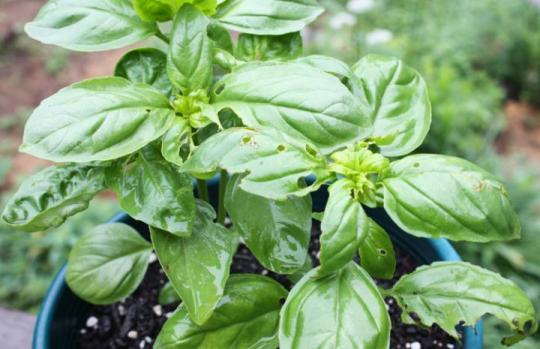
Earwig damage involves jagged leaves with holes, which can be seen on this damaged basil plant. Photo Credit: Barbara Pleasant.
Control and Prevention
How to Get Rid of Earwigs
Generally, earwigs are not as much of a threat to your garden as other pests, like Japanese beetles and aphids, though they can be as big of an annoyance! They can also produce a foul odor when disturbed, so keep that mind. Try these remedies:
Lay one-foot sections of bamboo or garden hose in the beds between your plants. Check these “traps” each morning, and dump the earwigs into a bucket of soapy water.
Spread petroleum jelly around the stems of your plants. Earwigs won’t crawl over it.
If they are infesting your woodpile, try sprinkling borax around it, but keep pets and children away from this area after doing so.
Oil pit traps are a great remedy for earwigs. Combine equal parts soy sauce and olive or vegetable oil, put it in a small plastic container, and secure the lid. Punch holes in the top of the container, near the lid. Make the holes large enough for the earwigs to get in. Bury the container in the soil just up to the holes. The soy sauce will attract the earwigs, and the oil will prevent them from escaping. Change the mixture as needed.
Alcohol controls these pests by acting as a surfactant, or wetting agent, that can penetrate an insect’s waxy coat of armor and kill on contact with the body. Isopropanol (rubbing alcohol) works fine and is easy to find, but be sure it doesn’t have additives. Ethanol (grain alcohol) seems to work best. Alcohol usually comes in 70 percent strength in stores (or 95 percent strength purchased commercially). To make an insecticidal spray, mix equal parts 70 percent alcohol and water (or, if using 95 percent alcohol, mix 1 part alcohol to 1 ½ parts water).
WARNING: Before using an insecticidal spray on your plants, test it on a single leaf. Wait 24 hours and observe to see if the plant has an adverse reaction. If it does, dilute your alcohol solution more and test again.
Earwigs are also susceptible to diatomaceous earth (DE), so consider placing a ring of DE around the bases of plant if the soil is dry enough. In wet weather, DE is not effective.
How to Prevent Earwigs
Expect more earwigs during rainy years, and prepare accordingly.
Avoid growing susceptible plants near walls covered in ivy or hedges, as many earwigs might live in these areas.
Birds and toads are both natural predators of earwigs. Check out our tips for creating a bird-friendly garden.
Occasionally, earwigs will move from mulch and other moist material outside into your house. They aren’t harmful, but can be an annoyance nonetheless. To prevent this, check for bugs on everything you bring inside, especially laundry, lawn furniture, flowers, vegetables, houseplants, and firewood. Also, move mulch away from your house’s foundation and establish a zone of bare soil that will dry out. If earwigs do happen to get into your home, vacuum them up.
What do you want to read next?
Source: https://livingcorner.com.au
Category: Garden
source https://livingcorner.com.au/earwigs/
0 notes
Text
Seedbed/Stratification questions;
An ACTUAL garden/plantblr related post that is a question (well, set of questions all relating to one topic).
Cold Stratification can be done in many forms; moist paper towel wrapped seeds in the fridge, potted seeds in the fridge, or just outright slapping the seeds into the garden for the winter. My questions however pertain to stratifying with a seedbed outdoors;
In a canadian cold climate (so zone 3-5 range), how effective would it be to have a raised seedbed outside full of potted seeds for stratification? Are there any specifications (in particular materials/depth/dimensions) that should be followed for the seedbed itself? Is the freeze/thaw from snow melting and refreezing again (cause YAY CLIMATE CHANGE) in the dead of winter detrimental to the seeds (as it can be deadly to certain containerized mature plant species) or does it not really give any negative impact unless they are actually germinating from the thaw? Since you don’t want seeds germinating too early should the seedbed in question be facing the north side of a place rather than the south side that coldframes normally are placed? Should specific steps be made to deter seed eating critters like a metal screen on top? Should it have glass on top like a coldframe or kept more open to get the full wintry effects?
We’re thinking of making a raised wooden that will be not too different (save for the fact the new one will be outside the greenhouse rather than inside) from the old set up that we currently have inside the greenhouse (old af pic, ignore the humidity dome);

Wherein we have a wooden raised bed full of soil/peat and have seeded pots placed in the seedbed, and the seedbed will be protected by a metal screen and will be on the north side outside of the greenhouse. it’d be placed on top of stone pavers and landscape fabric to keep the grass/weeds from growing from below. If there’d be any concern involving stuff germinating too late I’d probably either bring stuff out of the seedbed and into indoors or into the greenhouse at a certain point to be sure they get kickstarted. Would such a set up be effective for stratifying many various flora or are there some things we’ve not factored in?
It’d have mostly native plant seeds primarily (Acer, Cercis, Jack in the pulpit, Quercus, mostly any native plant that requires stratification), along with certain difficult long-term stratificators like Paperbark Maple (I SWEAR I WILL GET SEEDLINGS OF THEM ONE DAY but I need a set up that can be tended to but left be for potentially 4 years due to the durable shell).
Probably posting this too late as the seedbed is probably underway already but I need to put this stress to rest.
#GOOGLE IS BEING AGGRAVATINGLY VAGUE ON THESE SPECIFICS#plantblr#gardenblr#seed germination#seed#plants#stratification#botany#horticulture#gardeners of tumblr#gardeners on tumblr
59 notes
·
View notes
Text
Bonsai
Bonsai is the art of growing dwarf trees and shrubs from seedlings or rooted cuttings. It requires careful training, pruning and container restriction – the latter giving bonsai its name as it translates as 'tray cultivation'. This is a fun and beautiful way of cultivating plants on a miniature scale.
Most trees and shrubs can be grown as outdoor bonsai. The act of restricting growth causes the leaves to become reduced in size. Naturally small-leaved plants such as azaleas lend themselves most readily to bonsai, but bear in mind that their leaves will become smaller still. Scot's pine (Pinus sylvestris), larch (Larix sp.), Cercis sp, maidenhair tree (Ginkgo sp.), Lonicera nitida, yew (Taxus baccata) and Japanese maple (Acer sp.) are all good for starting your collection off.

Branch pruning and training bonsai
The pruning of bonsai is very specific to individual species of tree. In the beginning, a young bonsai would require pruning about once a year in order to form your ultimate shape. Once established, plants require pruning and trimming several times a year to keep them balanced and in shape.
Deciduous trees can be pruned at any time – as their style and shaping dictates – but major work is best undertaken from late winter to early spring
Major work on conifers and other evergreens should be undertaken in autumn or winter, but they can be lightly pruned at any time of year. Pines are an exception: twist off two thirds to a half of their 'candles' (new shoots) as they lengthen in late spring
Japanese maples should be hard-pruned in autumn or early winter, not spring as cuts may 'bleed' sap. Prune shoots as necessary during the growing season while they are still soft
Branch training and shaping is an art form in itself. Branches are coerced into many different arrangements by using wire wrapped along each branch and then moved into place.
Indoor bonsai are rather like houseplants. They are usually tropical or semi-tropical species and require lots of light, constant temperature and humidity, along with regular watering (as for outdoor bonsai). Depending on the species, some will lose a few old leaves in the spring to make way for some new ones. Plants regularly used are Chinese elm (Ulmus parvifolia), silver jade plant (Crassula arborescens), weeping fig (Ficus benjamina), celtis (Celtis bungeana) and olive (Olea europaea).
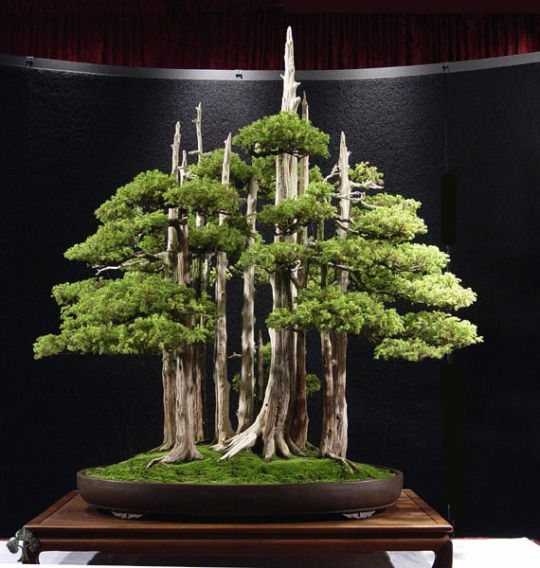
While the art of bonsai has long been associated with Japan, it actually originated first in China, and then spread eastward to Korea and then Japan. The art of bonsai was spread by Buddhist monks who wished to bring the “outdoors” inside their temples. From ancient paintings and manuscripts, we know that “artistic” container trees were being cultivated by the Chinese around 600 AD, but many scholars feel that bonsai, or at least potted trees, were being grown in China as far back as 500 or 1,000 BC. Bonsai first appeared in Japan during the 12th century.
Finally, we owe a great debt to the Japanese and Chinese artists for developing this beautiful art and for keeping it alive for almost 2,500 years. Without their enthusiasm, artistic tradition, and patient stewardship, we would not be enjoying bonsai as we know it today. The aesthetic sensibilities of bonsai, which have their roots in the Zen Buddhist tradition, contribute significantly to the complete bonsai experience.
Bonsai Artworks:
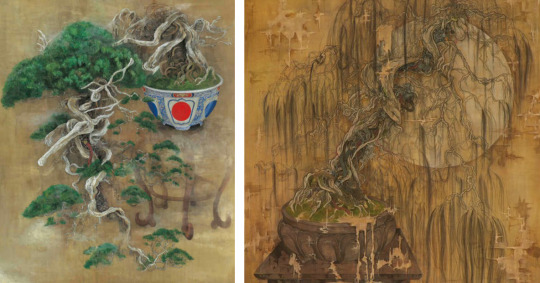


1 note
·
View note
Text
Me and my Weepers by Garden Rant
Guest Post by Bob Hill.
I have never fully understood my attraction to weeping plants and I really don’t want to pay some nerdy-looking guy with a psychology degree about $250-an-hour to find out.
Truth be told, I’ve spent some time drinking beer and exchanging words like “theorization” and “anosognosia” with otherwise likeable shrinks who at some point toward midnight will confess to being every bit as off-the-edge as their patients, only more expensive.
That’s when I start dropping horticulture words like “cleistogamous” and “farinaceous” on them just to level up the conversation. With any luck the bartender will lock up and go home before we get to Rostrinucula dependens.
The best I can figure, I just like the aesthetics of weepers. Contrary to what their name might imply, I never see a hint of depression in them, or even gloom. They are simply unique, graceful, confident individuals taking off in a whole different series of directions.
At once.
Weeping redbud ‘Ruby Falls’
They do nicely in small spaces, can survive in containers or on a larger section of landscape. In one of the best trips of my life, I saw a weeping larch sprawling for about 30 feet along a low fence in a New Zealand nursery; 10 yards of horticultural happiness.
With deciduous weeping trees, I also like how they look in the winter, poetic, bare-limbs in a tangle, anxiously waiting for spring and another bird’s nest.
For some deep research on the causes of this weeping-plant phenomena I refer you to a 2012 Associated Press article written by Lee Reich, who at first opined that some trees weep “because they want to grow down.”
His analysis picked up from there. Reich suggested a weeping tree may have begun life as a random seedling whose quirky arrangement of genes directed its stems to weep, generally after a short period of more normal upright growth, which would also explain some recent political events.
“Perhaps the mutation was caused by sunlight or temperature; perhaps it was spontaneous,” he wrote. “At any rate, all new stems and branches originating from those changed cells weep.”
Weeping trees, however, are very unlikely to produce like offspring from their seeds. They have to be grafted onto similar rootstock, preferably high enough off the ground to create a nice waterfall effect. Then there is always that one branch outlier that wants to go back to growing straight up, another reason why God invented pruning shears.
Weeping katsura in winter
There are all the usual weeping suspects; cherry trees, apple trees, birch and Japanese maples. All fine, but my absolutely favorite is the weeping katsura ‘Amazing Grace,’ your cercidiphyllum japoncium.
It has become our wrap-around tree. Maybe 25 feet tall and wide, with drooping, enveloping limbs, we have placed a bench beneath it, a chandelier hanging overhead, a fireplace mantle off to one side. You can hide beneath its wings, read a book under there, peer out at the world instead of always having it peering in at you.
On a smaller scale, another favorite is our weeping redbud Cercis Canadensis ‘Ruby Falls.’ It literally hangs out along the driveway, a “Welcome Home” tree with tighter, pendulous limbs and purple-red leaves that follow the rose-red blooms. Maybe it’s just its size, but it seems a little more reclusive, as if its hiding something under there.
With weeping conifers, my experience, especially when they are small, is they are either happy in my landscape or soon dead. Best I can tell, almost no one in the Midwest grafts them for sale. Here in Indiana, I mostly have to import them from the West Coast or East Coast, which may help explain the dead part, or find a local outlier with some a knack for the art. But that also seems to be a dying breed.
For the most part, my best weepers just show up here in a big tan box dropped off from a brown UPS truck, and not especially better for the experience. Some of the box stores are beginning to stock pint-sized conifers in sets, but none of them are weepers, and too many of them are soon dead, too. It might have been helpful if some roots had been included.
Weeping balsam fir
Two of our weeping conifers that have survived nicely include our weeping bald cypress Taxodium distichum, and weeping balsam fir, Abies balsamea.
The bald cypress seems to favor an upright stance, with limbs plunging down toward the earth. It always reminds me of an old man who loses his hair every fall and re-grows it in spring. We also have the “Peve Mineret,” which is a really tight cultivar that looks like a dwarf old man from the git-go.
Our balsam fir was maybe 18 inches tall when we got it, and we’ve raised it like it was our own child. We made the mistake of planting it too close to another tree, and now the two are fighting it out for space, but I haven’t the heart to cut one down or the time, money or equipment to transplant the fir.
An alternate name for this tree is Balm of Gilead. Reason alone to keep it around.
Weeping conifers can fill a small space nicely, or go sprawling up, out and down across the landscape. They can also buddy-up, and, in time, are often found clumped together at one end of the conifer display garden, probably making fun of bolt-upright homo sapiens.
Retired Louisville Courier-Journal columnist and author Bob Hill is owner of the eight-acre Hidden Hill Nursery & Sculpture Garden near Utica, Indiana. Hidden Hill specializes in rare and unusual plants, whimsy and unfettered moonlight. For more information see hiddenhillnursery.com.
Me and my Weepers originally appeared on Garden Rant on March 22, 2017.
from Garden Rant http://gardenrant.com/2017/03/me-and-my-weepers.html
0 notes
Photo


Siblings by birth, friends by choice.
#they may be stressful but they are stinkin cute#ts4#ts4 gameplay#seedlingsib#simsinbloom#cercis seedling#oxalis seedling#seedling3
21 notes
·
View notes
Photo





“Daddy? Momma ok? Why shout loud?”
“She’s... saying hello to your new brother or sister.”
“Baby outside?”
“It’s better just to do whatever she says just now sweetie”
From outside.
“TWINS! CHAR! YOU UTTER B*&!£rd”
#ts4#ts4 gameplay#seedlingsib#simsinbloom#the end of a constant cycle of pregnancies due to rolling 4 kids this gen#seedling3#Nepeta Seedling#Charcoal Blaze#cercis seedling#tw: birth
16 notes
·
View notes
Photo


“Mom - I already opened my gifts...”
“Yes but then the maker put you in those clothes so... well... you look like a tiny octogenarian”
#TS4#ts4 gameplay#simsinbloom#seedlingsib#Nepeta Seedling#oxalis seedling#cercis seedling#Charcoal Blaze#seedling3
15 notes
·
View notes
Photo



Cercis appreciation post
9 notes
·
View notes